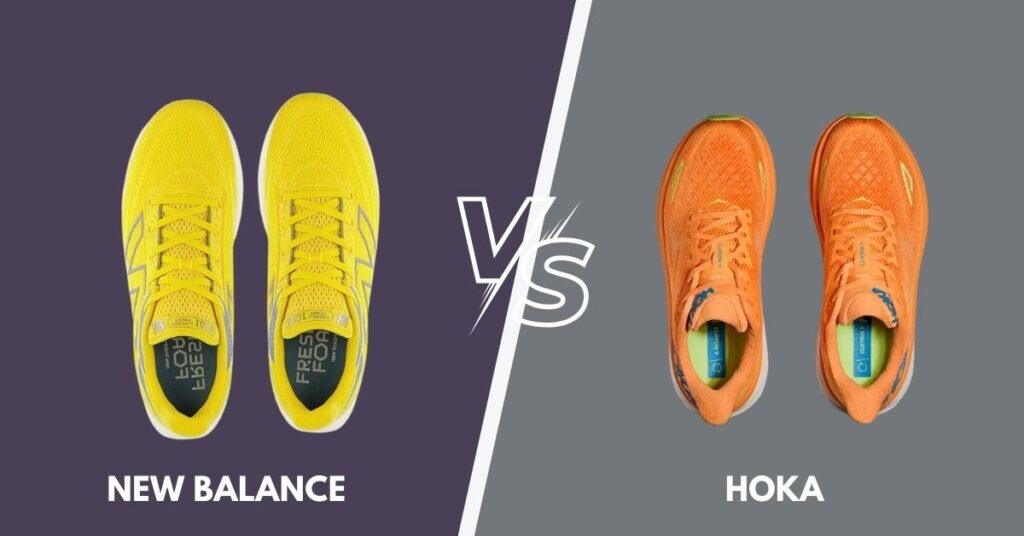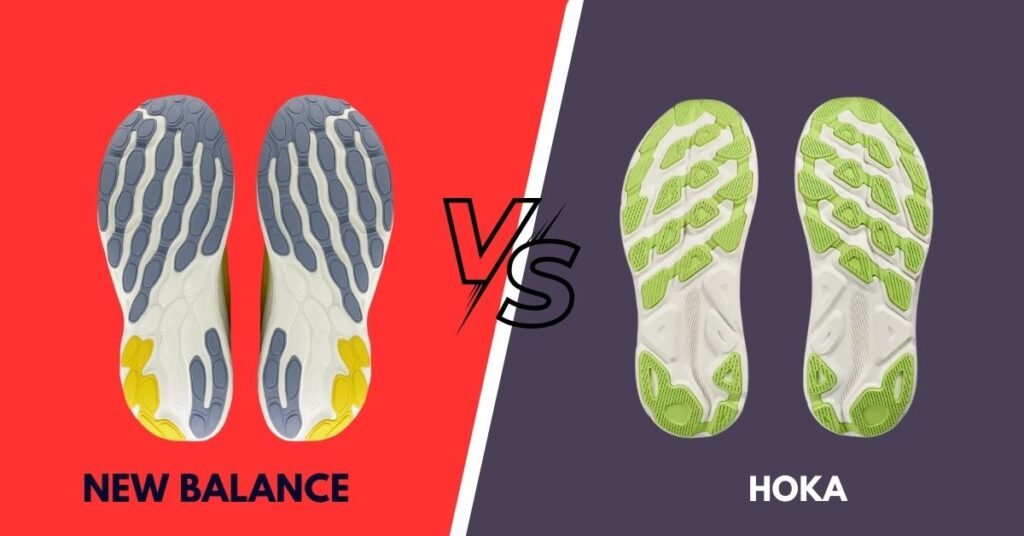If you are in the market for a new pair of running or walking shoes, you have probably come across Hoka vs New Balance. Both brands have built a strong reputation for delivering top-tier performance, comfort, and durability. But which one is right for you?
Choosing between Hoka vs New Balance isn’t just about looks—it’s about finding the perfect fit for your feet, running style, and overall comfort. In this guide, we’ll take a deep dive into the differences between Hoka and New Balance, covering everything from design and cushioning to price and durability.

Hoka vs New Balance: Brand Overview
Before we compare their features, let’s look at what makes each brand unique.
Hoka: The King of Max Cushioning
Founded in 2009, Hoka quickly gained popularity for its ultra-cushioned midsoles and rocker-shaped design. These features make Hoka shoes incredibly comfortable, supportive, and ideal for long-distance running or recovery days.
✔️ Key Features of Hoka Shoes:
1. Extra-thick midsoles for superior cushioning
2. Meta-Rocker technology for a smooth stride
3. Lightweight despite their bulky appearance
4. Ideal for long-distance runners and walkers
New Balance: Comfort Meets Performance
When we talk about the comfort for New Balance, New Balance has been a household name in the footwear industry for over 100 years. Known for its balanced cushioning, variety of widths, and stylish designs, New Balance appeals to a wide range of runners, walkers, and casual wearers.
✔️ Key Features of New Balance Shoes:
1. Fresh Foam and FuelCell cushioning for comfort & performance
2. Available in multiple width options (narrow to extra-wide)
3. Great for everyday running, training, and lifestyle wear
4. Durable construction for long-term use
Now that we have an overview, let’s compare them in detail.
1. Design & Aesthetics
When it comes to looks, Hoka and New Balance take very different approaches.
Hoka Design
Hoka shoes have a chunky, futuristic design with high-stack midsoles and bold colorways. The thick foam makes them stand out, and while some runners love this “cloud-like” look, others find it too bulky.
New Balance Design
New Balance, on the other hand, offers a more classic, sleek, and versatile design. Many of their models can be worn casually and athletically, making them a stylish option beyond just running.
Winner: New Balance for everyday wearability, but Hoka if you love bold, high-cushion aesthetics.
2. Comfort & Fit
If comfort is your top priority, both brands have a lot to offer.
Hoka Comfort
Hoka’s maximalist cushioning makes them feel like walking on pillows. Their shoes are excellent for people with knee or joint pain and are a top choice for marathon runners and walkers. However, some models run narrow, which might not be ideal for people with wide feet.
New Balance Comfort
New Balance takes the lead in fit variety. Unlike Hoka, they offer multiple width options, making them perfect for runners with wide feet. Their Fresh Foam and FuelCell midsoles provide a soft yet responsive feel.
Winner: New Balance for better fit options, Hoka for ultra-soft cushioning.

3. Cushioning & Midsole Technology
Both brands specialize in advanced midsole technologies, but they cater to different needs.
Hoka Cushioning
Hoka uses EVA foam with a high stack height, providing soft landings and reduced impact. Their Meta-Rocker technology helps guide your stride forward, making running feel smoother.
New Balance Cushioning
New Balance offers two primary cushioning systems:
- Fresh Foam X – Plush, soft, and great for daily running.
- FuelCell – More responsive and bouncy, great for speed.
Winner: Hoka for soft cushioning, New Balance for a balance of comfort and performance.
4. Outsole & Traction
A good outsole ensures grip and durability on various surfaces.
Hoka Outsoles
Hoka’s rubberized foam outsoles provide a smooth ride, but they wear down faster than traditional rubber soles.
New Balance Outsoles
New Balance uses blown rubber outsoles, which are more durable and provide better traction on roads and trails.
Winner: New Balance for durability.
5. Performance for Running & Walking
| Feature | Hoka | New Balance |
| Best For | Long-distance running, recovery, walking | Daily running, speed training, casual wear |
| Cushioning | Ultra-plush | Balanced |
| Support | Moderate | High (wide-foot options available) |
| Energy Return | Moderate | High (FuelCell models) |
| Durability | Good | Excellent |
| Width Options | Limited | Extensive |
Winner: Hoka for long runs, New Balance for versatility.
6. Durability & Longevity
Hoka shoes last around 300-500 miles, but their soft foam wears down faster.
New Balance shoes, on the other hand, can last 500+ miles, thanks to their reinforced outsoles and sturdy construction.
Winner: New Balance for durability.
7. Price & Value for Money
Both brands have similar price points ($120-$180).
✔ Hoka is worth it for those who need ultra-soft cushioning and joint relief.
✔ New Balance offers better long-term value due to its durability and versatile use.
Winner: New Balance for overall value.

8. Who Should Choose Which Brand?
| Who Should Choose? | Hoka | New Balance |
| Max Cushioning Lovers | ✅ Best Choice | ❌ Not as plush |
| Wide Feet Runners | ❌ Limited Options | ✅ Best Choice |
| Long-Distance Runners | ✅ Excellent | ✅ Also great |
| Casual Wear & Lifestyle | ❌ Less stylish | ✅ Great options |
| Speed & Performance | ❌ Less responsive | ✅ FuelCell models excel |
| Walking & Recovery | ✅ Ultra-soft | ✅ Comfortable |
Final Verdict: Hoka vs New Balance
✔ Choose Hoka if you need maximum cushioning and a soft ride for long-distance running, walking, or recovery days.
✔ Choose New Balance if you want a durable, versatile shoe with multiple width options for everyday running, training, and casual wear.
Overall Winner between Hoka vs New Balance
New Balance for Versatility, Hoka for Cushioning
Both brands are fantastic, but your choice depends on what matters most—cushioning, fit, durability, or versatility.
Which one do you prefer? Let us know in the comments!

Pingback: Hoka Arahi 6 vs New Balance 860: Which Shoe is Right for You? - feetelo.com